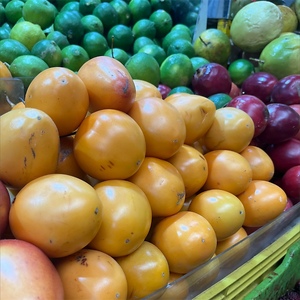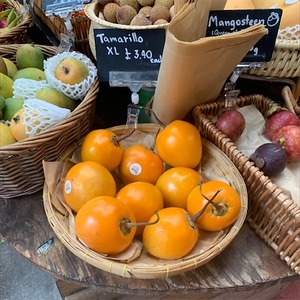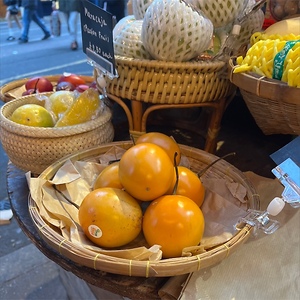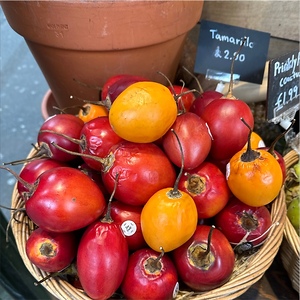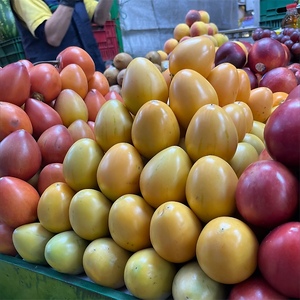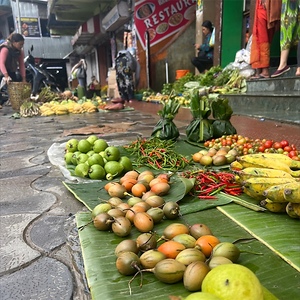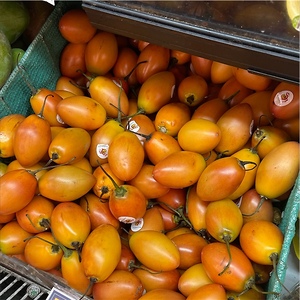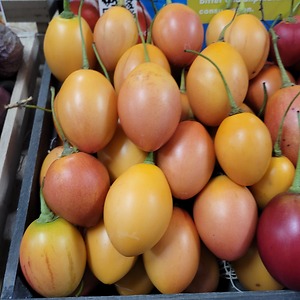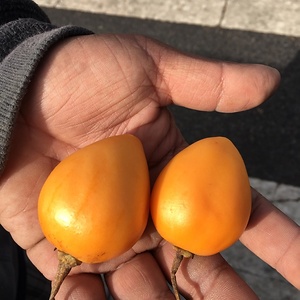


Gold Tamarillos
Estimated Inventory, 30 ct : 0
Description/Taste
Gold tamarillos are small fruits, averaging 2 to 8 centimeters in length and 2 to 5 centimeters in diameter, and have an oblong to oval, egg-shape with tapered, pointed ends. The fruit’s skin is thin but tough, with a smooth, glossy, and yellow to amber hue. Underneath the surface, there is a layer of golden flesh with a dense, soft, and slightly firm consistency, surrounding two chambers of gelatinous pulp. The aqueous, slippery pulp is dark orange and encases many flat, thin, and round, cream-colored seeds. Ripe Gold tamarillos have some give to the surface when pressed and emit a fragrant aroma. The skin of the fruit contains a high tannin content, rendering it bitter and unpalatable for consumption. Gold tamarillo flesh is the only part of the fruit consumed and includes a sharp and acidic, sweet-tart flavor with piquant, vegetal, and bitter undertones.
Seasons/Availability
Gold tamarillos are available in the fall through winter.
Current Facts
Gold tamarillos, botanically classified as Solanum betaceum, are subtropical fruits belonging to the Solanaceae or nightshade family. The smooth, oblong fruits grow in clusters of 3 to 12 fruits on an evergreen tree or shrub that reaches 1 to 4 meters in height. Gold tamarillos are favored for their sharp, subtly sweet, and acidic flavor. Several types of tamarillos are cultivated worldwide that are found in varying colors, including red, gold, amber, and purple, with red tamarillos being the most commercially produced. Gold tamarillos are a lesser-known type, valued for their sweeter flavor, and in local markets, the gold fruits are sometimes interchangeably sold with amber varieties to simplify the point of sale for consumers. Globally, tamarillos are considered fruits, but in culinary preparations, they can also be prepared like a vegetable, utilized by chefs in both sweet and savory applications. Gold tamarillos are also known as Tomate de Arbol, Yellow tamarillo, and Tree Tomatoes, and some of the common Golden tamarillo cultivars include Solid Gold, Ecuadorian Orange, Inca Gold, Bold Gold, and Goldmine.
Nutritional Value
Gold tamarillos are an excellent source of vitamins A and C to boost collagen production within the skin, reduce inflammation, and strengthen the immune system. The fruits are also a good source of fiber to regulate the digestive tract, potassium to balance fluid levels, vitamin E to protect against free radical damage, and provide lower amounts of iron, copper, phosphorus, magnesium, zinc, and manganese. In addition to vitamins and minerals, Gold tamarillos contain citric acid and malic acid, contributing to the flesh’s sour, tart flavor.
Applications
Gold tamarillos have a tangy, acidic flavor well suited for both sweet and savory culinary preparations. The fruit’s skin is inedible due to its bitter taste and must be removed before consumption. The fruits can be blanched, dropped in an ice bath, and peeled, or the flesh can be scooped from the skin similarly to a kiwi. When using in sweeter dishes, Gold tamarillos need to be mixed with honey, brown sugar, or maple syrup to create a palatable sweet-tart flavor. The flesh is popularly chopped and combined with a sweetener, left overnight to soak in sugar. Once the flavors have merged, the sweet, tangy flesh can be incorporated into oatmeal, yogurt, or porridge, or it can be used as a topping over ice cream and other desserts. Gold tamarillos can also be baked into cakes and muffins, mixed into apple crumble, simmered into jams, jellies, and marmalades, or poached in a red wine and sugar syrup mixture. In addition to sweet preparations, Gold tamarillos have an acidic nature that complements savory dishes. The fruits are used like a tomato and are commonly chopped into salsas and chutneys, cooked into glazes for meat and hot sauces, tossed into salads and fruit bowls, quartered and grilled for a smokey accent, or roasted to develop light caramelization. The fruits can also be cooked into frittatas, simmered into ratatouille, or stirred into other soups and stews. In South America, Gold tamarillos are pureed and blended into smoothies and drinks, traditionally with ice, milk, and sugar, or they are pickled as a tangy condiment. Gold tamarillos pair well with meats such as duck, lamb, pork, and beef, fruits including apples, coconut, lemons, and oranges, mushrooms, eggplant, bell peppers, chile peppers, herbs such as oregano, basil, and mint, cinnamon, star anise, lime leaves, hazelnuts, honey, and brown sugar. Whole, unwashed Gold tamarillos will keep 3 to 7 days at room temperature to ripen, and once mature, they will last 1 to 2 weeks when tightly wrapped in plastic and stored in the refrigerator. If the raw flesh is cut, store it in a sealed container for 2 to 3 days. Cooked Gold tamarillos will keep up to 4 days in the refrigerator. The fruits can also be pureed or peeled and frozen for extended use.
Ethnic/Cultural Info
Gold tamarillos were first commercially grown in New Zealand and were introduced to the island in the 1890s from Asia. The small fruits were naturally bred and selected over time to showcase improved cultivation techniques, and since their introduction, tamarillos have remained a favored home garden plant, especially in northern New Zealand. Tamarillos also earned their unique name from a rebranding effort through the New Zealand Tree Tomato Promotions Council. The council felt that the fruit’s original name, Tree Tomato, was too confusing for consumers and wanted to distinguish it from the common tomato. The name tamarillo was created from the Maori word “tama,” meaning “leadership,” and “rillo,” a Spanish-inspired creation believed to have been taken from “amarillo,” meaning “yellow.” The exotic name was released in 1967 and was met with favor, as the name was memorable, reminding growers of the fruit’s South American origins.
Geography/History
Gold tamarillos are native to the Andes Mountains, spanning across Peru, Bolivia, Chile, and Ecuador. The subtropical fruits have been cultivated on Peruvian mountainsides since pre-Columbian times, and on the Colombian and Ecuadorian uplands, it is found in almost every city from Bogotá to Quito. Regardless of its widespread cultivation throughout the subtropics, tamarillos are still considered a garden fruit and have yet to be heavily produced commercially. During the second half of the 20th century, New Zealand established the first commercial production, selecting improved varieties and rebranding the fruit as tamarillo in 1967. Over time, Gold tamarillos began to be internationally exported to Japan, Australia, North America, and Europe. Today Gold tamarillos are cultivated throughout South America, Central America, the Caribbean, New Zealand, Australia and are also grown on a smaller scale in North America and Asia. When in season, Gold tamarillos are found through local markets, specialty distributors, and select grocers.
Recipe Ideas
Recipes that include Gold Tamarillos. One
| Jacki's Bento Blog |
|
Poached Tamarillo with Cherry Syrup |
| Bron Marshall |
|
Mustard Crusted Pork Fillet on Tamarillo Carpaccio |
| Laylita's Recipes |
|
Tamarillo Hot Sauce |



